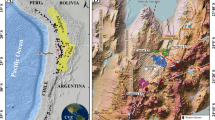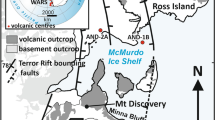Abstract
The La Breña — El Jagüey Maar Complex, of probable Holocene age, is one of the youngest eruptive centers in the Durango Volcanic Field (DVF), a Quaternary lava plain that covers 2100 km2 and includes about 100 cinder and lava cones. The volcanic complex consists of two intersecting maars — La Breña and El Jagüey — at least two pre-maar scoria cones and associated lavas, and a series of nested post-maar lava and scoria cones that erupted within La Breña Maar and flooded its floor with lava to form one or more lava lakes. We believe that El Jagüey Maar formed first, but pyroclastic deposits associated with its formation are exposed at only a few places in the lower maar walls. A perennial lake in the bottom of El Jagüey marks the top of an aquifer about 60 m below the lava plain. Interaction of the rising basanitic magmas with this aquifer was probably responsible for the hydromagmatic eruptions at the maar complex. In the southeastern quadrant of La Breña and in most parts of El Jagüey, the upper maar walls expose a thick pyroclastic sequence of tuffs, tuff breccias, and breccias that is dominated by thinly layered sandwave and plane-parallel surge beds and contains minor interlayered scoria-fall horizons. We conclude that these deposits in the upper walls of both maars erupted during the formation of La Breña, based on: (1) thickness variations in a prominent scoria-fall marker bed interlayered with the surge deposits; (2) inferred transport directions for ballistic clasts, channels, and dune-like bedforms; and (3) lateral facies changes in the surge deposits. Some of the surge clouds from La Breña apparently travelled down the inner southwestern wall of El Jagüey, fanned out across its floor, and climbed up the opposite walls before emerging onto the surrounding lava plain. These clouds deposited steep, inward-dipping surge deposits along the lower walls of El Jagüey. Following this hydromagmatic phase, which was responsible for the formation of the maars, a series of strombolian eruptions took place from vents within La Breña. At many places along the maar rims these eruptions completely buried the surge beds under a thick sequence of post-maar scoriae and ashes. The outer flanks of the maar complex and the surrounding lava plain are also blanketed by post-maar ashes. The final phase of activity involved effusive eruptions of post-maar lavas from vents on the floor of La Breña. The evolutionary sequence from hydromagmatic eruptions during formation of the maars, through strombolian eruptions of the post-maar scoriae and ashes, and finally to the post-maar lavas appears to reflect the declining influence of magma-groundwater interactions with time. Basanitic magmas from all eruptive stages carried spinel-lherzolite and feldspathic-granulite xenoliths to the surface. The La Breña — El Jagüey Maar Complex contains the only known hydromagmatic vents in the DVF and the largest spinel-lherzolite xenoliths, which range up to 30 cm diameter. These two observations indicate an unusually rapid ascent rate for these basanitic magmas compared to those from other DVF vents.
Similar content being viewed by others
References
Albritton CC Jr (1958) Quaternary stratigraphy of the Guadiana Valley, Durango, Mexico. Geol Soc Am Bull 69:1197–1216
Aquirre-Díaz GJ, McDowell FW (1991) The volcanic section at Nazas, Durango, Mexico, and the possibility of widespread Eocene volcanism within the Sierra Madre Occidental. J Geophys Res 96:13373–13388
Aranda-Gómez JJ (1982) Ultramafic and high grade metamorphic xenoliths from central Mexico. Ph D thesis, Eugene, University of Oregon, pp 1–236
Aranda-Gómez JJ, Ortega-Gutiérrez F (1987) Mantle xenoliths in Mexico. In: Nixon PH (ed) Mantle xenoliths. Wiley, New York, pp 75–84
Bacon CR, Carmichael ISE (1973) Stages in the P-T path of ascending basalt magma: an example from San Quintín, Baja California. Contrib Mineral Petrol 41:1–22
Basu AR (1977a) Textures, microstructures and deformation of ultramafic xenoliths from San Quintín, Baja, California. Tectonophysics 43:213–246
Basu AR (1977b) Olivine-spinel equilibria in lherzolite xenoliths from San Quintín, Baja California. Earth Planet Sci Lett 33:443–450
Basu AR (1978) Trace elements and Sr-isotopes in some mantle-derived hydrous minerals and their significance. Geochim Cosmochim Acta 42:659–668
Basu AR (1979) Geochemistry of ultramafic xenoliths from San Quintín, Baja, Californai. In: Boyd FR, Meyer OA (eds) The mantle sample: inclusions in kimberlites and other volcanics. Proceedings of the Second International Kimberlite Conference, Am Geophys Un, Washington, DC, 2, pp 391–399
Basu AR, Murthy VR (1977) Ancient lithospheric lherzolite xenoliths in alkali basalt from Baja California. Earth Planet Sci Lett 35:239–246
Bergman SC, Foland KA, Spera FJ (1981) On the origin of an amphibole-rich vein in a periodite inclusion from the Lunar Crater Volcanic Field, Nevada, USA. Earth Planet Sci Lett 56:343–361
Cabanes N, Mercier J-CC (1988) Insight into the upper mantle beneath an active extensional zone: the spinel-peridotite xenoliths from San Quintín (Baja California, Mexico). Contrib Mineral Petrol 100:374–382
Cas RAF, Wright JV (1987) Volcanic successions, modern and ancient. Allen & Unwin, London, pp 1–528
Crowe BM, Fisher RV (1973) Sedimentary structures in base-surge deposits with special reference to cross-bedding, Ubehebe Craters, Death Valley, California. Geol Soc Am Bull 84:663–682
Delaney PT (1982) Rapid intrusion of magma into wet rock: groundwater flow due to pore pressure increases. J Geophys Res 87:7739–7756
Eaton GP (1982) The Basin and Range Province: origin and tectonic significance. Ann Rev Earth Planet Sci 10:409–440
Fisher RV, Schmincke H-U (1984) Pyroclastic rocks. Springer-Verlag, Berlin, pp 1–472
Fitton JG, James D, Kempton PD, Ormerod DS, Leeman WP (1988) The role of lithospheric mantle in generation of late Cenozoic basic magmas in the western United States. J Petrol Spec Vol:331–349
Frey FA, Prinz M (1987) Ultramafic inclusions from San Carlos, Arizona: petrologic and geochemical data bearing on their petrogenesis. Earth Planet Sci Lett 34:129–176
Galer SJG, O'Nions RK (1989) Chemical and isotopic studies of ultramafic inclusions from the San Carlos Volcanic Field, Arizona: a bearing on their petrogenesis. J Petrol 30:1033–1064
Gutmann JT (1976) Geology of Crater Elegante, Sonora, Mexico. Geol Soc Am Bull 87:1718–1729
Gutmann JT (1977) Textures and genesis of phenocrysts and megacrysts in basaltic lavas from the Pinacate volcanic field. Am J Sci 277:833–861
Gutmann JT (1986) Origin of four-and five-phase ultramafic xenoliths from Sonora, Mexico. Am Min 71:1076–1084
Henry CD, Aranda-Gómez JJ (1990) The real southern Basin and Range: Mid-late Cenozoic extension in Mexico. Geol Soc Am Abstr Prog 22, 7:A228
Irving AJ (1980) Petrology and geochemistry of composite ultramafic xenoliths in alkalic basalts and implications for magmatic processes within the mantle. Am J Sci 280-A:389–426
Kempton PD (1987) Mineralogic and geochemical evidence for differing styles of metasomatism in spinel lherzolite xenoliths: enriched mantle source regions of basalts? In: Menzies MA, Hawkesworth CJ (eds) Mantle metasomatism. Academic Press, San Diego, pp 1–20
Kempton PD, Menzies MA, Dungan MA (1984) Petrography, petrology and geochemistry of xenoliths and megacrysts from the Geronimo volcanic field, southeastern Arizona. In: Kornprobst J (ed) Kimberlites II: The mantle and crust-mantle relationships, Elsevier, New York, pp 71–84
Kempton PD, Dungan MA, Blanchard DP (1987) Petrology and geochemistry of xenolith-bearing alkalic basalts from the Geronimo Volcanic Field, southeast Arizona: evidence for polybaric fractionation and implications for mantle heterogeneity. Geol Soc Am Spec Pap 215:347–370
Kienle J, Kyle PR, Self S, Motyka RJ, Lorenz V (1980) Ukinrek Maars, Alaska, I. April 1977 eruption sequence, petrology, and tectonic setting. J Volcanol Geotherm Res 7:11–37
Labarthe G (1978) Algunos xalapascos en el Etado de San Luis Potosi. Inst Geologia Metalurgia, San Luis Potosí, México, Univ Auton San Luis Potosí, Folleto Técnico 58, pp 1–17
Liang Y, Elthon D (1990) Geochemistry and petrology of spinel lherzolite xenoliths from Xalapasco de la Joya, San Luis Potosí, Mexico: partial melting and mantle metasomatism. J Geophys Res 95:15859–15877
Lorenz V (1973) On the formation of maars. Bull Bolcanol 37:183–204
Lorenz V (1986) On the growth of maars and diatremes and its relevance to the formation of tuff rings. Bull Volcanol 48:265–274
Luhr JF, Aranda-Gómez JJ, Pier JG (1989) Spinel-lherzolite-bearing Quaternary volcanic centers in San Luis Potosí, Mexico: 1. Geology, mineralogy, and petrology. J Geophys Res 94,B6:7916–7940
McDowell FW, Keizer RP (1977) Timing of mid-Tertiary volcanism in the Sierra Madre Oceidental between Durango City and Mazatlau México. Geol Soc Am Bull 88:1479–1487
Menzies M, Kempton PD, Dungan MA (1985) Interaction of continental lithosphere and asthenospheric melts below the Geronimo Volcanic Field, Arizona, USA. J Petrol 26:663–693
Mertes H (1983) Aufbau and Genese des Westeifeler Vulkanfeldes. Bochumer Geol Geotech Arb 9:1–415
Nimz G, Cameron KL, Cameron M, Morris J (1986) Petrology of the lower crust and upper mantle beneath southeastern Chihuahua. Geofisica Internacional 25-1:85–116
Ollier CD (1967) Maars: their characteristics, varieties, and definition. Bull Volcanol 31:45–73
Perry FV, Baldridge WS, DePaolo DJ (1987) Role of asthenosphere and lithosphere in the genesis of late Cenozoic basaltic rocks from the Rio Grande Rift and adjacent regions of the southwestern United States. J Geophys Res 92, B9:9193–9213
Pier JG, Podosek FA, Luhr JF, Brannon JC, Aranda-Gómez JJ (1989) Spinel-lherzolite-bearing Quaternary volcanic centers in San Luis Potosí, Mexico, 2. Sr and Nd isotopic systematics. J Geophys Res 94, B9:7941–7951
Pier JG, Luhr JF, Podosek FA, Aranda-Gómez JJ (1992) The La Breña-El Tagvey Maar Complex, Durango, Mexico: II Petrology and geochemistry Bull Volcanol (this volume) or give vol 4 pg 5
Spinel-lherzolite-bearing Quaternary volcanic centers in SAn Luis Potosí, Mexico, 2. Sr and Nd isotopic systematics. J Geophys Res 94, B6:7941–7951
Raisz E (1959) Landforms of Mexico: Cambridge, Massachusetts, scale 1:3 000 000
Reid JB Jr, Woods GA (1978) Oceanic mantle beneath the southern Rio Grande Rift. Earth Planet Sci Lett 41:303–316
Roberts SJ, Ruiz J (1989) Geochemistry of exposed granulite facies terrains and lower crustal xenoliths in Mexico. J Geophys Res 94, B6:7961–7974
Roden MF, Irving AJ, Murthy VR (1988) Isotopic and trace element compositions of the upper mantle beneath a young continental rift: results from Kilbourne Hole, New Mexico. Geochim Cosmochim Acta 52:461–473
Ruiz J, Patchett PJ, Arculus RJ (1988) Nd-Sr isotope composition of lower crustal xenoliths-evidence for the origin of mid-Tertiary felsic volcanics in Mexico. Contrib Mineral Petrol 99:36–43
Sánchez-Rubio G (1978) El Volcán La Breña, Estado de Durango. Univ Nac Autón México, Inst Geol Revista 2, 1:75–79
Saunders AD, Rogers G, Marriner GF, Ternell DJ, Verma SP (1987) Geochemistry of Cenozoic volcanic rocks, Baja California, Mexico: implications for the petrogenesis of post-subduction magmas. J Volcanol Geotherm Res 32:223–245
Self S, Kienle J, Huot J-P (1980) Ukinrek Maars, Alaska, II. Deposits and formation of the 1977 craters. J Volcanol Geotherm Res 7:39–65
Smith J, Luhr JF, Pier JG, Aranda-Gómez JJ (1989) Extension-related magmatism of the Durango Volcanic Field, Durango, Mexico. Geol Soc Am Abstr Prog 21, 6:A201
Spera FJ (1987) Dynamics of translithospheric migration of metasomatic fluid and alkaline magma. In: Menzies MA, Hawkesworth CJ (eds) Mantle Metasomatism. Academic Press, San Diego, pp 1–20
Stewart JH (1978) Basin-range structure in western North America: a review. Geol Soc Am Mem 152:1–31
Swanson ER (1989) A new type of mar volcano from the State of Durango — the El Jagüey-La Breña Complex reinterpreted. Univ Nal Autón México, Inst Geol Revista 8, 2:243–247
Wilshire HG, Shervais JW (1975) Al-augite and Cr-diopside ultramafic xenoliths in basaltic rocks from western United States: structural and textural relationships. Phys Chem Earth 9:257–272
Wilshire HG, Meyer CE, Nakata JK, Calk LC, Shervais JW, Nielson JE, Schwarzman EC (1988) Mafic and ultramafic xenoliths from volcanic rocks of the western United States? US Geol Surv Prof Pap 1443:pp1–179
Wohletz KH, Sheridan MF (1979) A model of pyroclastic surge. Geol Soc Am Spec Pap 180:177–194
Wohletz KH, Sheridan MF (1983) Hydrovolcanic explosions II. Evolution of basaltic tuff rings and tuff cones. Am J Sci 283:385–413
Womer MB, Greely R, King JS (1980) The geology of Split Butte — a maar of the south-central Snake River Plain, Idaho. Bull Volcanol 43:453–471
Zindler A, Jagoutz E (1988) Mantle cryptology. Geochim Cosmochim Acta 52:319–333
Author information
Authors and Affiliations
Rights and permissions
About this article
Cite this article
Aranda-Gómez, J.J., Luhr, J.F. & Pier, G. The La Breña — El Jagüey Maar Complex, Durango, México: I. Geological evolution. Bull Volcanol 54, 393–404 (1992). https://doi.org/10.1007/BF00312321
Received:
Accepted:
Issue Date:
DOI: https://doi.org/10.1007/BF00312321




